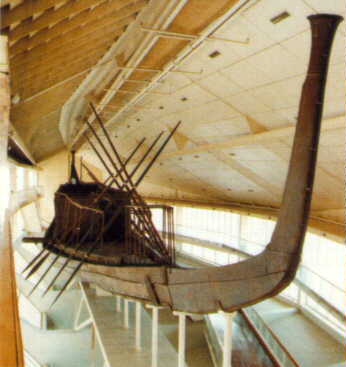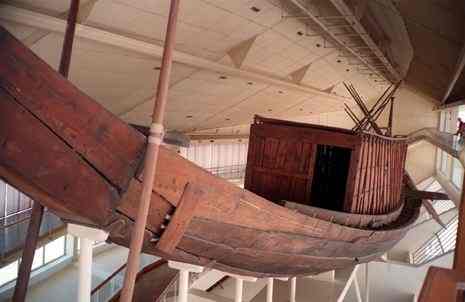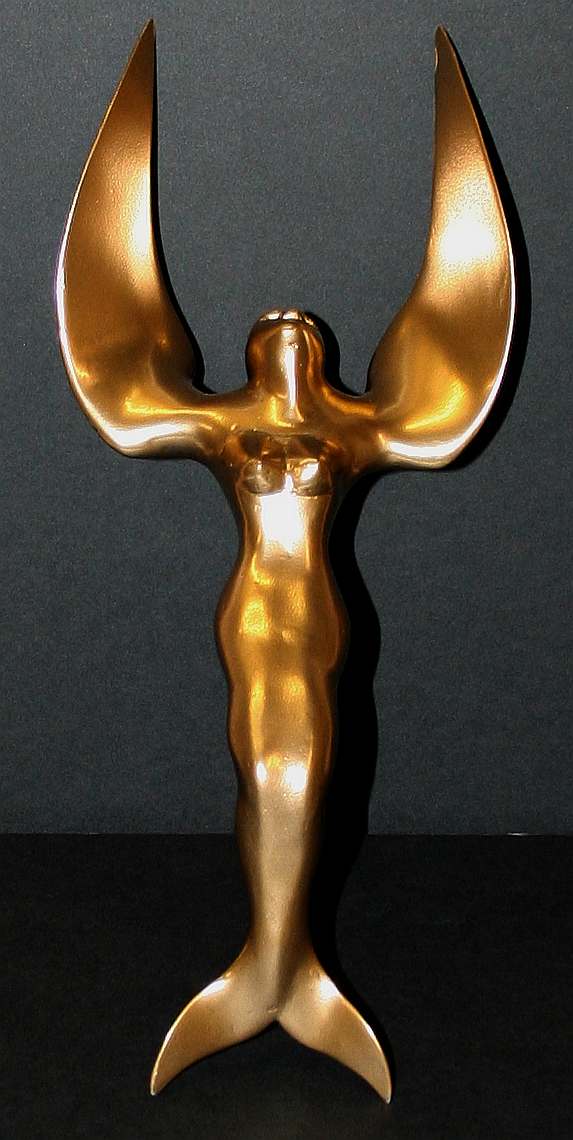In
1950, Kamal el-Mallakh an architect and archaeologist, was
working as an Antiquities Inspector at Giza, when he first
noticed a thin line of mortar which delineated the edge of a
pair of long narrow pits, end to end, on the south side of the
Great Pyramid of Khufu. At the time the area was being cleared
for a tourist road and when the men dug further they uncovered
41 huge slabs of limestone in the eastern pit (the western one
contained 40 slabs) and a mason's mark with a cartouche of
Djedefre, Khufu's successor. The stonework was at first
thought to be of little interest and it took Kamal el-Mallakh
four years to persuade his superiors that the slabs should be
further investigated.
On
May 26 1954, the team began to dig and eventually Mr el-Mallakh
was lowered into a hole in one of the blocks. His first
sensation was the sweet smell of cedarwood and a great sense
of fulfilment - then with the use of a torch and a mirror he
caught sight of the large oar of a full-sized dismantled boat.
The pit had been airtight and the boat seemed to be in a
remarkable state of preservation, arranged in thirteen neatly
piled layers, complete with ropes for rigging and pieces of
matting.
The
boat was laboriously removed from its pit, piece by piece,
following preliminary consolidation of the cloth and matting
which covered it and in 1958 reconstruction of the boat, by
Hag Ahmed Youssef Moustafa the Antiquities Service's principal
restorer, was able to begin. This consisted of re-assembling
the 1224 individual pieces of cedar, acacia and other elements
in a painstaking operation rather like putting together a
jig-saw puzzle without a picture. The ancient builders had
helpfully indicated on some of the pieces which parts of the
craft they had come from, but the work still took over ten
years to complete and was finally fully re-assembled in 1968.
No nails were used in the construction and the planking was
assembled through an ingenious system of stitching through
holes with ropes of vegetable fibres. When the wood was
swollen by water the ropes would tighten and make the boat
watertight.

Egyptian
Solar Boat
The
solar boat measures 43.3m long, 5.9m wide, has a draft of
1.48m and an estimated displacement of around 45 tons. It
resembles paintings and models of boats which have survived
since ancient times, with a large central panelled cabin, 9m
long, an open canopy supported by poles and a smaller one at
the fore which was probably for the captain's use. It was
steered by five pairs of oars plus one pair at the stern to
act as a rudder. It's stem and stern were fashioned in the
form of papyrus stalks, as though intended to represent the
type of papyrus boat used throughout ancient Egyptian history.
The
significance of the buried boat is still debated. The Pyramid
Texts clearly state that at the end of the pharaoh's life on
Earth, his soul ascends to the heavens in the solar barque to
join his father Re. The arguments are about whether this boat
was purely symbolic - part of the burial goods - or whether it
was actually used in the funeral procession to transport the
body of the king by river to his pyramid complex. While some
scholars claim that there is evidence that the boat has been
in water, Zahi Hawass points out that shavings of cedar and
acacia found in the pit during excavation, indicate that it
was probably built close to where it was buried. While the
boat is of the right dimensions to be suitable as a river
craft, no mast was found with the components.
Other
ancient wooden boats and their emplacements have been
discovered in Egypt. In 1893 Jaques de Morgan discovered six
boats near the Middle Kingdom pyramid of Senwosret III at
Dashur. More recently, in 1987, the western boat pit at the
Great Pyramid was examined by a microprobe inserted through a
hole drilled into the pit, confirming the presence of a second
wooden boat similar to the first. It has been decided that the
second boat will remain in its pit, in conditions which make
its preservation near perfect.
In 1991 American archaeologist David O'Connor discovered
twelve boat pits near Khasekhemwy's Dynasty II funerary
enclosure at Abydos (Shunet el-Zebib), although it has been
recently established by experts that the boats had been placed
in the pits long before the enclosure was built. Each of the
pits was found to contain remains of a wooden boat, though not
as well-preserved as Khufu's. Interestingly, the boats were
filled in with mudbricks, each one itself boat-shaped. In a
period when wood is believed to have been a rare and precious
commodity in Egypt, it is hoped that this exciting discovery
will provide many insights into power and foreign
relationships at the beginning of Egyptian history. Two more boats were discovered at Abydos in the year 2000, making a
total of fourteen boats thought to predate those of Khufu by
at least 300 years.
Khufu's
solar boat remains the most spectacular of all Egyptian boats
found to date. It is now on display in its own specially-built
museum just a few metres from where it was found on the
southern side of the monument, an imposing legacy from the
builder of the Great Pyramid.

Egyptian
Solar Boat

ANCIENT
EGYPTIAN PYRAMIDS |
CAT
GODDESSES LINKS
|
CAT MUMMIES
| CLEOPATRA
QUEEN OF EGYPT |
CLEOPATRA
PHARAOH
GIZA
| JULIUS
CAESAR
| PHARAOHS
| PYRAMIDS
| RA - SUN
GOD |
SOLAR BOAT
| SOLAR
BOAT


